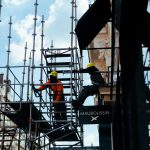Understanding the Landscape of Austin Construction
Overview of Austin Construction Trends
The Austin construction industry is evolving, driven by accelerated population growth, technological advancements, and a robust economy. Over recent years, Austin has become a focal point for real estate development, featuring a blend of residential, commercial, and public infrastructure projects designed to accommodate its expanding demographic. Urbanization trends indicate an increasing demand for housing, particularly multifamily units, while commercial sectors witness a surge in office spaces to support burgeoning tech startups. This ambitious growth is accompanied by innovative designs and sustainable building practices as the city strives for environmental accountability amid its rapid development journey.
Key Players in the Austin Construction Market
The construction landscape in Austin is characterized by a diverse array of stakeholders. Key players include general contractors, subcontractors, architects, engineers, and government entities. The collaborative efforts of these professionals are crucial in shaping the built environment. Established firms often partner with up-and-coming contractors to leverage local insights, while architects are increasingly incorporating sustainable design principles into their projects. Additionally, city planners and regulators play a pivotal role, ensuring that construction activities adhere to prevailing codes and promote responsible growth.
Regulations Affecting Austin Construction Projects
Understanding the regulatory framework is essential for navigating Austin’s construction landscape. Builders must comply with various federal, state, and local regulations, including zoning laws, building codes, and environmental regulations. The City of Austin has established a detailed set of guidelines known as the Land Development Code, which delineates permissible land uses and provides standards for site development. This code supports sustainable urban planning principles and reflects the city’s commitment to preserving green spaces amid extensive development.
Building Codes and Regulations in Austin
Important Codes for Austin Construction Compliance
Building codes form the backbone of construction quality and safety. In Austin, the International Building Code (IBC) serves as the cornerstone for ensuring structural integrity and occupant safety. Compliance with these codes is enforced through rigorous inspections at various stages of construction. It’s crucial for developers to stay abreast of updates to these codes, as they evolve in response to technological advancements and shifts in construction practices.
Permitting Process for New Development in Austin
The permitting process is an essential step for any new development in Austin. This process involves submitting detailed plans and documents to the City of Austin’s Development Services Department. Applicants must provide evidence of adherence to zoning regulations, building codes, and other necessary standards. The review process can be complex, often requiring adjustments to plans based on feedback from city officials. Engaging with professionals who are well-versed in the permitting process can streamline approvals and mitigate potential delays.
Environmental Considerations in Austin Construction
Environmental considerations are increasingly paramount in the Austin construction sector. As sustainability becomes a focal point of urban development, builders are tasked with minimizing their environmental footprint. This involves implementing energy-efficient practices, sourcing sustainable materials, and complying with regulations regarding stormwater management and habitat preservation. Projects are often subject to environmental reviews that assess their potential impacts on local ecosystems, ensuring a balance between growth and ecological conservation.
Innovative Techniques in Austin Construction
Embracing Sustainable Practices in Austin Construction
Austin’s construction industry is at the forefront of sustainable building practices. Techniques such as green roofing, solar panel installation, and rainwater harvesting are becoming standard practice. Furthermore, the use of LEED certification not only enhances project appeal but also provides tangible benefits in energy savings and increased marketability. Builders are now seeking innovative materials like recycled composites and low-VOC (volatile organic compounds) paints, which contribute to healthier living environments and lower environmental impact.
Technology Integration in Austin Construction Projects
Technology plays a pivotal role in transforming construction processes. The incorporation of Building Information Modeling (BIM) enables contractors and architects to visualize their projects in a virtual environment, improving coordination and reducing errors. Additionally, project management software ensures efficient collaboration among team members and helps track costs and timelines. Drones and 3D printing are also increasingly being adopted for site surveys and fabrication, ushering in a new era of efficiency and precision in the Austin construction landscape.
Case Studies of Successful Austin Construction Innovations
Examining case studies reveals the profound impact of innovation in the Austin construction sector. A notable example is the use of modular construction techniques at various multifamily housing projects, which have significantly reduced construction timelines and labor costs. Another case is the integration of smart technologies into commercial spaces, where innovations enhance energy efficiency and provide advanced user experiences. These case studies serve as benchmarks, inspiring other projects to adopt similar innovative approaches for improved outcomes.
Challenges Facing the Austin Construction Sector
Labor Shortages Impacting Austin Construction
The Austin construction sector faces a critical challenge with labor shortages impacting project timelines and costs. Factors such as an aging workforce and the burgeoning demand for skilled trades have contributed to this predicament. To address these shortages, many firms are investing in workforce development programs that train young professionals and encourage diversity within the industry. Partnerships with local technical schools and continuous training initiatives can cultivate a talent pipeline that meets the demands of the rapidly evolving market.
Supply Chain Issues in Austin Construction
Supply chain disruptions have also posed significant challenges in recent years. Increased demand for building materials, coupled with global supply chain issues, has led to delays and rising costs. Companies must adapt by establishing stronger relationships with suppliers and exploring alternative sourcing strategies. Additionally, embracing local suppliers can reduce transportation costs and timelines, while fostering regional economic development.
Addressing Affordability in Austin Construction Projects
Affordability remains a pressing issue in the Austin construction landscape, given the city’s rapid growth and rising real estate prices. Developers are increasingly exploring innovative financing models, such as public-private partnerships, to deliver affordable housing solutions. The city’s commitment to affordability can also be seen in its zoning reforms aimed at increasing density and enabling a range of housing options. Collaboration with local nonprofits and housing advocates further enhances the efficacy of these initiatives.
Future of Austin Construction
Emerging Trends in Austin Construction
Looking ahead, several trends are poised to shape Austin’s construction environment. The emphasis on sustainability will likely continue as climate concerns gain prominence. Additionally, smart city technologies, including Internet of Things (IoT) applications, are expected to play an increasingly significant role in urban infrastructure development. Moreover, flexible workspaces that can adapt to evolving business needs will be in high demand, dictating changes in how commercial spaces are designed.
Government Initiatives Supporting Austin Construction Growth
Government initiatives aimed at supporting construction growth in Austin are critical to the city’s development strategy. Current policies focus on fostering a conducive environment for investment through streamlined permitting processes and infrastructure funding. The city has also launched grant programs to incentivize sustainable practices and affordable housing development. These initiatives exemplify the collaborative efforts necessary to sustain growth while ensuring long-term community benefits.
Predictions for Austin Construction Market Evolution
Predictions for the Austin construction market suggest a continued trend toward diversification and innovation. The demand for adaptive reuse projects—transforming older buildings for modern use—is expected to rise, capitalizing on sustainability and historic preservation. Additionally, advancements in construction technologies will further expedite project delivery and enhance cost efficiency. Increased emphasis on community engagement in planning processes will also be vital, ensuring that developments meet the desires and needs of an ever-evolving population.





